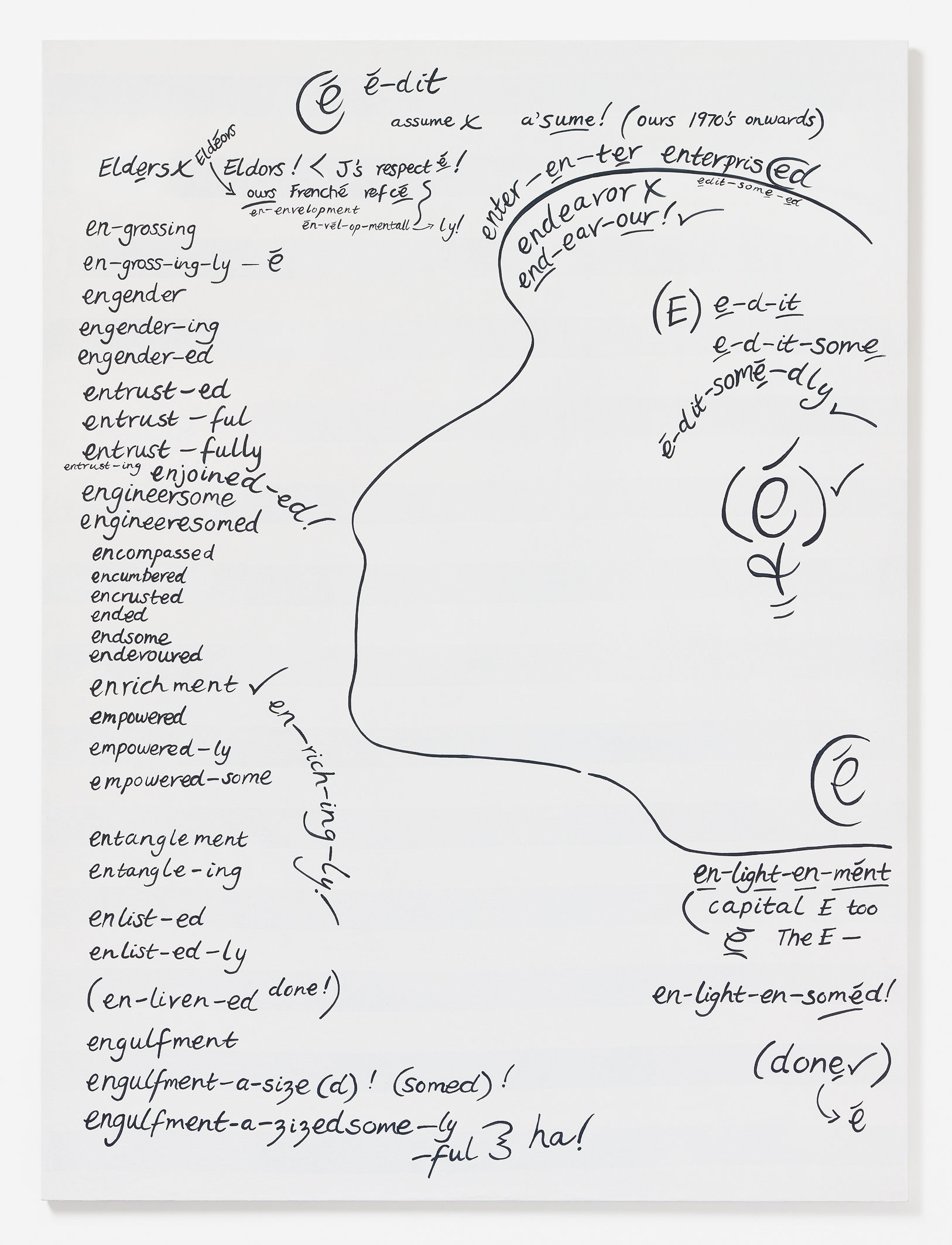
Language is crucial to Darcey Bella Arnold’s paintings and installations. Words appear throughout the Melbourne-based artist’s work, in rhythms and forms that are almost impossible to replicate with typed script, as the text in one 2020 painting, é dit, reveals:
en-grossing en-gross-ing-ly — é engender engender-ing engender-ed entrust-ed entrust-ful entrust-fully
It’s a mesmerising display of grammatical iterations. Yet these words are not Arnold’s but her mother’s, Jennifer’s.
In 2004, after an acquired brain injury following a viral infection, which also resulted in significant memory loss, Jennifer developed aphasia, altering her communication. Soon Jennifer began writing and editing, filling notebooks with words and ‘correcting’ the writings of others with the utmost precision – all in friendly, neat cursive. Without knowing the story behind Arnold’s art, it looks as if someone, dissatisfied with the forms of language, has tenderly dissected it, losing language to find new forms of communication.
At first, Arnold brought fragments of Jennifer’s writing onto canvases and painted large-scale replicas of the front of Jennifer’s Spirax notebooks. But recently, something has shifted within this metamorphosis – Arnold is using Jennifer’s words as a departure to fundamentally question language and meaning, with paintings as deceivingly simple as the letter ‘a’ repeated in various sizes and directions. Script has become purely visual. Words and letters are marks in the world, like any other painterly brushstroke.
Tiarney Miekus: I know that Jennifer was a teacher, and held a natural interest in words – but prior to her aphasia, was she interested in language? Were words, literature, or poetry topics of conversation?
Darcey Bella Arnold: Not particularly, which is intriguing! However, Jennifer has always loved reading and has a respect for the written word. Books were always very important at home as a child; I am one of four children and she had us all reading for education and enjoyment. It is interesting that she is so focused on words post-illness: she plays with them verbally in everyday conversation and in her writing and correcting – she corrects the newspaper regularly, for example. It is her favourite subject and brings her (and us) much joy.
Another intriguing element of her aphasia is the mixing of French and English. We also don’t really know why this has come about as prior to her illness she didn’t have any particular interest in the French language, apart from learning it at high school for a year or two.
TM: It’s always interesting when a visual artist focuses on language, and in your work it’s especially profound because it’s the form of language rather than the content. You’re not communicating through a phrase or word, like Barbara Kruger for example. Was that interest in language always there, or has it developed over time?
DBA: I have always loved text works, like Barbara Kruger as you point out, and artists such as Elizabeth Newman, Jon Campbell, Mutlu Cerkez, Emily Floyd and Gordon Bennett. So, the interest has always been there, and I have played with language as form and message since I graduated art school in 2007. What has developed is my thinking around language, it is a fallible form of communication. It’s a medium to be played with, to have fun with, following my mother’s example.

Darcey Bella Arnold, é dit, acrylic on canvas, board framed 120 x 90 cm. Courtesy Darcey Bella Arnold and ReadingRoom, Naarm/Melbourne.
TM: Fun isn’t often a word used amidst language (thinking of how so many writers talk about the suffering of working with language). Can you talk about how you play with language, and why that’s fun to you?
DBA: Play in the studio for me is an essential part of making, the research is there, in the background, but the time spent with the materials is such a huge part of making art.
TM: When you saw the development of your mother’s writing and notebooks, was there a particular moment when you decided to bring those words into your practice?
DBA: There was a particular conversation I had with my partner, Simon McGlinn, before a solo exhibition at the Sutton Project Space in 2018. I had produced a new suite of paintings and titled the show My Mother’s Labour – I was thinking of concepts around storytelling and feminism, and by coincidence, I had simultaneously also been writing a personal essay about Jennifer. Once I had written the piece, I showed it to her and naturally, she wanted to correct it for me. The writing describes her language change, and there was something wonderful about the writing describing this change and her and marking the paper – it felt active and playful, alive, a portrait of her in a way. I showed this writing to Simon, and he pointed out that it could be the written component to My Mother’s Labour, and this was the beginning of bringing this personal element into my practice. This took much consideration and discussion with family, as it is personal. I wanted to make sure my siblings and Michael (Arnold’s father) were all happy with it being told.













